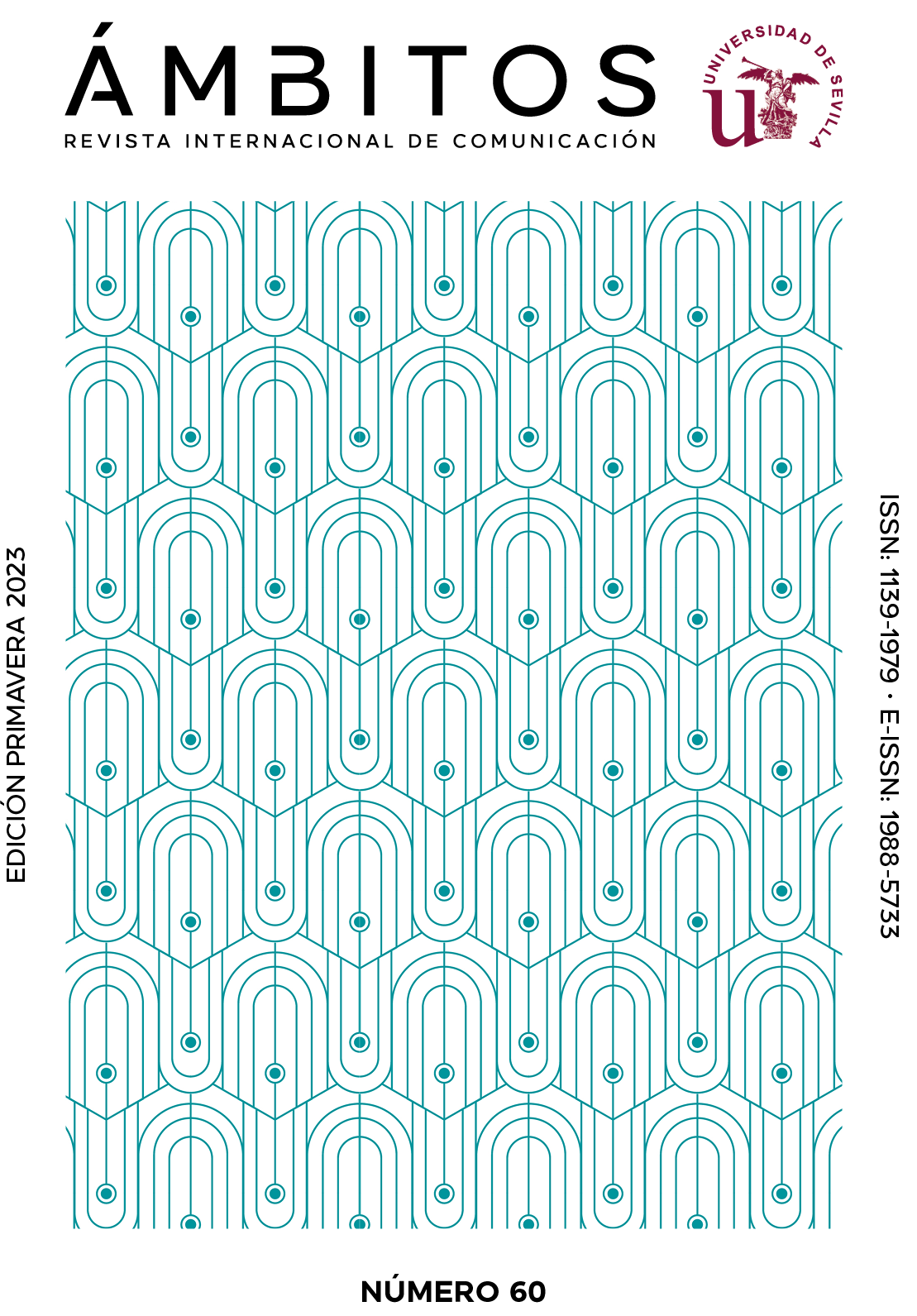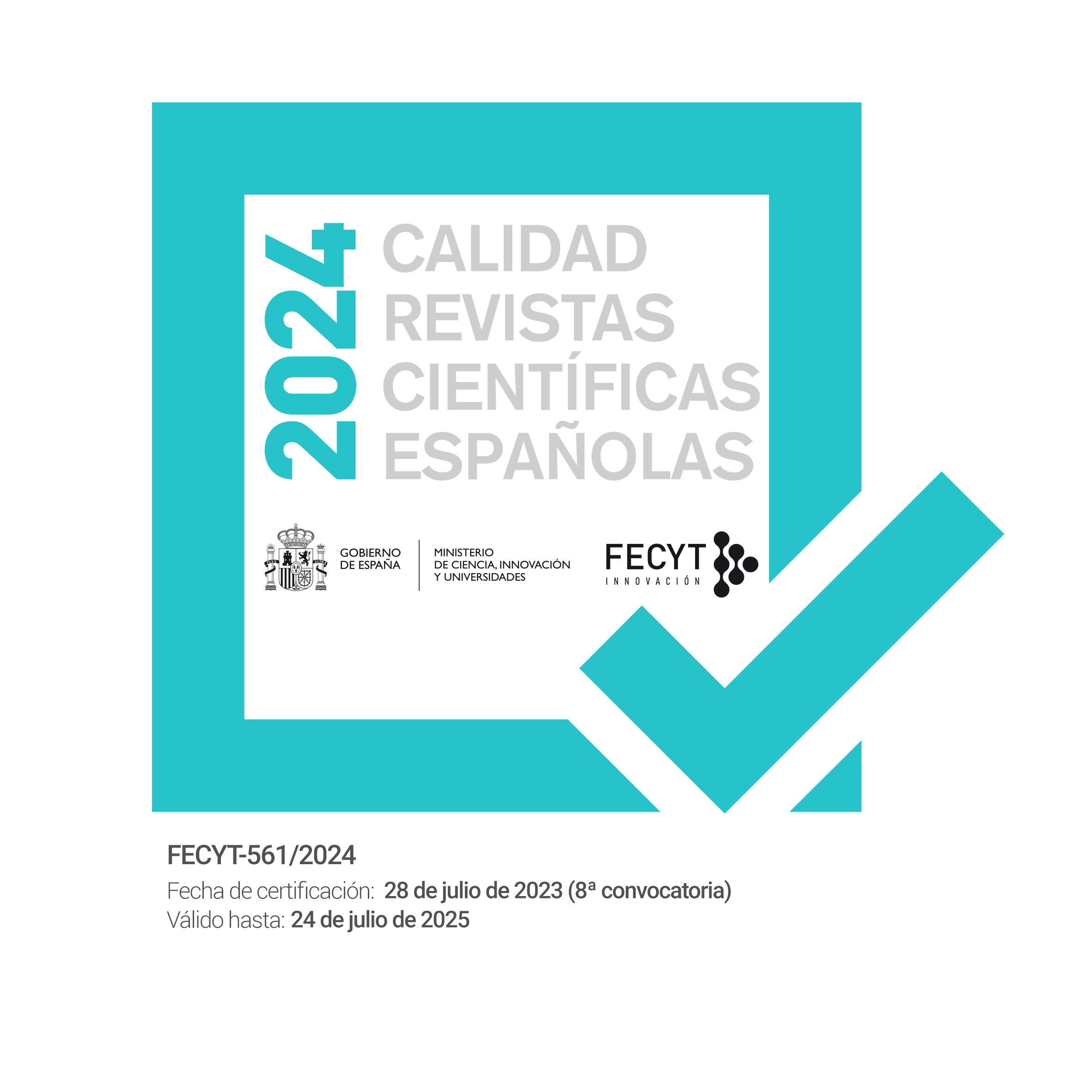Sport and TikTok: content typology of Spanish sportsmen and women at the Tokyo 2020 Olympic Games
DOI:
https://doi.org/10.12795/Ambitos.2023.i60.02Keywords:
TikTok, Olympic Games, Tokyo 2020, personal branding, sports managementAbstract
TikTok has emerged in recent years as the fastest growing social network. Entertainment content, the consumption of short videos, the proliferation of content creators and interaction are the main reasons that attract the Z generation, the main users of this network, but also other generations who are also looking to be entertained. Sport as a whole, and sportsmen and women in particular, have found in the platform a way to contact and converse in a more intimate and personal way. This paper studies in an exploratory way the use of TikTok as a communication channel of Spanish athletes who have competed in the Tokyo 2020 Olympic Games. The aim is to categorize and understand the communications issued by athletes on TikTok. The methodological design consists of a content analysis of the profiles of 12 Olympic athletes in the stage before, during and after the Tokyo Olympic Games, analysing a total of 431 publications, and eight in-depth interviews to professionals from the world of sport (managers, athletes and communicators). That contrast the previous phase. The results show the sportsmen and sportswomen assumption of the network’s codes, the use of Olympic symbols as the backdrop for their dynamics and the extent of greater interaction and engagement with their followers depending on the type of content. This study expands knowledge about athletes and personal brands in a little explored area and provides conceptual and management keys for communication and social media managers.
Downloads
Metrics
References
Abuín-Penas, J., Míguez-González, M. I. y Martínez-Patiño, M. J. (2020). Instagram como herramienta de relaciones públicas para los deportistas de élite españoles. Revista Internacional de Relaciones Públicas, 10(19), 91-110.
https://doi.org/10.5783/RIRP-19-2020-06-91-110
Abuín-Penas, J., Martínez-Patiño, M. J., & Míguez-González, M. I. (2019). Spanish Winter Olympic athlete’s communication on Instagram. Journal of Human Sport and Exercise, 14(4proc), 780-791.
https://doi.org/10.14198/jhse.2019.14.Proc4.40
Álvarez, J. (2021, 27 de enero). Digital Report 2021. El informe sobre las tendencias digitales, redes sociales y mobile. We Are Social. bit.ly/40itEDV
Álvarez-Gayou, J. L. (2004) Cómo hacer investigación cualitativa. Fundamento y metodología. Paidós Educador
Anderson, K. E. (2020). Getting acquainted with social networks and apps: It is time to talk about TikTok. Library Hi Tech News, 37(4), 7-12.
https://doi.org/10.1108/LHTN-01-2020-0001
Butterworth, M. L. (2021). Communication and sport: an emergent field. En M. Butterworth (ed.), Communication and Sport (pp. 1-22). De Gruyter Mouton.
https://doi.org/10.1515/9783110660883-001
Chadwick, S., & Burton, N. (2008). From Beckham to Ronaldo - Assessing the Nature of Football Player Brands. Journal of Sponsorship, 1(4), 307-317.
COI (2020). Normas sobre el uso de redes sociales y medios digitales Juegos de la XXXII Olimpiada - Tokyo 2020. bit.ly/3Y8jl3z
Congosto, M. (2015). Elecciones Europeas 2014: Viralidad de los mensajes en Twitter. REDES. Revista hispana para el análisis de redes sociales, 26(1), 23-52.
https://doi.org/10.5565/rev/redes.529
Curry, D. (2022). TikTok App Report 2022. bit.ly/3jeXhW3
Feder, L. (2020). From ESPN to Instagram LIVE: The Evolution of Fan–Athlete Interaction Amid the Coronavirus. International Journal of Sport Communication, 13(3), 458-464.
https://doi.org/10.1123/ijsc.2020-0233
Fernández-Peña, E. y Ramajo Hernández, N. (2014). La comunicación en el deporte global: Los medios y los Juegos Olímpicos de verano (1894-2012). Historia y Comunicación Social, 19(3), 703-714.
https://doi.org/10.5209/rev_HICS.2014.v19.45171
Figuereo-Benítez, J. C., González-Quiñones, F. y Machin-Mastromatteo, J. D. (2021). Instagram como objeto de estudio en investigaciones recientes. Una revisión de literatura con enfoque en revistas científicas. Ámbitos. Revista Internacional de Comunicación, 53, 9-23.
https://doi.org/10.12795/Ambitos.2021.i53.01
Figuereo-Benítez, J. C., Oliveira, J. S. d. y Mancinas-Chávez, R. (2022). TikTok como herramienta de comunicación política de los presidentes iberoamericanos. En J. I. Aguaded Gómez, A. Vizcaíno Verdú, Á. Hernando Gómez, & M. Bonilla-del-Río (Eds.), Redes sociales y ciudadanía: Ciberculturas para el aprendizaje (pp. 103-112). Grupo Comunicar Ediciones.
Forman, L. (2022, 13 de mayo). TikTok Is Eating Up Rivals. Can It Keep Users Hooked? The Wall Street Journal. bit.ly/3WPAvSx
García Rivero, A., Citlali Martínez, E. y Bonales Daimiel, G. (2022). TikTok y Twitch: Nuevos medios y fórmulas para impactar en la Generación Z. Revista ICONO 14. Revista Científica de Comunicación y Tecnologías Emergentes, 20(1). Advance online publication.
https://doi.org/10.7195/ri14.v20i1.1770
Geurin, A. N. (2017). Elite female athletes’ perceptions of new media use relating to their careers: A qualitative analysis. Journal of Sport Management, 31(4), 345-359.
https://doi.org/10.1123/jsm.2016-0157
Geurin-Eagleman, A. N., & Burch, L. M. (2016). Communicating via photographs: A gendered analysis of Olympic athletes’ visual self-presentation on Instagram. Sport Management Review, 19(2), 133-145.
https://doi.org/10.1016/j.smr.2015.03.002
Ginesta, X. (2020). Les multinacionals de l’entreteniment. Fútbol, diplomacia, identitat i tecnologia. Editorial UOC.
Green, M. (2016). The impact of social networks in the development of a personal sports brand. Sport, Business and Management, 6(3), 274-294.
https://doi.org/10.1108/SBM-09-2015-0032
Green, D., Polk, X. L., Arnold, J., Chester, C., & Matthews, J. (2022). The Rise Of TikTok: A Case Study Of The New Social Media Giant. Management and Economics Research Journal, 8(1), 1-6.
https://doi.org/10.18639/MERJ.2022.9900063
González Fernández-Villavicencio, N., Menéndez Novoa, J. L., Seoane García, C. y San Millán Fernández, M. E. (2013). Revisión y propuesta de indicadores (KPI) de la Biblioteca en los medios sociales. Revista Española de Documentación Cientifica, 36(1), e005.
https://doi.org/10.3989/redc.2013.1.919
Hambrick, M. E., Simmons, J. M., Greenhalgh, G., & Greenwell, C. (2010). Understanding professional athletes’ use of Twitter: A content analysis of athlete tweets. International Journal of Sport Communication, 3(4), 454-471.
https://doi.org/10.1123/ijsc.3.4.454
Hambrick, M. E., & Mahoney, T. Q. (2011). ‘It’s incredible – trust me’: Exploring the role of celebrity athletes as marketers in online social networks. International Journal of Sport Management and Marketing, 10(3-4), 161-179.
https://doi.org/10.1504/IJSMM.2011.044794
IAB Spain (2022). Estudio anual de redes sociales. https://iabspain.es/
Jackson, D., Bernstein, A., Butterworth, M., Cho, Y., Coombs, D.S., Devlin, M., & Onwumechili, C. (2021). Olympic and Paralympic Analysis 2020: Mega events, media, and the politics of sport. bit.ly/3jhFRbu
Kolsquare (2022). Todo lo que necesitas saber sobre las cifras de engagement en 2022. bit.ly/3Rjr8ZZ
Lobillo-Mora, G. y Aja Gil, M. (2020). Estudio de presencia digital en MotoGP. Estudio del caso de Jorge Lorenzo en Instagram. Ámbitos. Revista Internacional de Comunicación, 48, 102-122.
https://doi.org/10.12795/Ambitos.2020.i48.06
Martínez Valerio, L. (2023). Mensajes misóginos en los perfiles de TikTok de la prensa española: Estudio y percepción por parte de los jóvenes. Ámbitos. Revista Internacional de Comunicación, 59, 110-127.
https://doi.org/10.12795/Ambitos.2023.i59.08
Mejía-Llano, J.C. (2020, 22 de octubre). Indicadores en redes sociales: principales KPIs y métricas en Social Media. bit.ly/3wH0Ask
Meso Ayerdi, K., Pérez Dasilva, J. A. y Mendiguren Galdospin, T. (2021). Futbolistas en Twitter. Una plataforma para la autopromoción. Revista De Comunicación, 20(2), 277-301.
https://doi.org/10.26441/RC20.2-2021-A15
Moragas Spà, M. (1992). Los juegos de la comunicación: las múltiples dimensiones comunicativas de los Juegos Olímpicos. Fundesco.
Núñez, V. (2017, 17 de enero). Fórmula para calcular engagement en redes sociales y CTR [plantillas]. bit.ly/3wDFzP8
Parmentier, M. A., & Fischer, E. (2012). How athletes build their brands. International Journal of Sport Management and Marketing, 11(1-2), 106-124.
https://doi.org/10.1504/IJSMM.2012.045491
Pedersen, P. M. (2013). Routledge Handbook of Sport Communication. Routledge.
Pegoraro, A. (2010). Look who’s talking-Athletes on Twitter: A case study. International Journal of Sport Communication, 3(4), 501-514.
https://doi.org/10.1123/ijsc.3.4.501
Pegoraro, A., & Jinnah, N. (2012). Tweet ‘em and reap ’em: The impact of professional athletes’ use of Twitter on current and potential sponsorship opportunities. Journal of Brand Strategy, 1(1), 85-97.
Peters, T. (1997). The brand called you. Fast company. bit.ly/3XKVlUi
PricewaterhouseCoopers (2020). Termómetro del ecosistema del deporte en España. bit.ly/3YbuH6H
Rojas, P. y Redondo, M. (2017). Cómo monetizar las redes sociales. LID Editorial.
Rooney, B. (2012). Social Media Proves Gold for Promoting Athletes. The Wall Street Journal.
Sanahuja-Peris, G., Mayorga-Escalada, S. y Herrero-Gutiérrez, F. J. (2021). Deporte y comunicación. Una mirada al fenómeno deportivo desde las ciencias de la comunicación en España. Tirant lo Blanch.
Sánchez-Amboage, E., Toural-Bran, C., Membiela-Pollán, M. y Crespo-Pereira, V. (2022. Short video content en la estrategia de marca. Análisis del uso de Tik Tok por el Museo del Prado. Revista Mediterránea de Comunicación/Mediterranean. Journal of Communication, 13(1), 331-343.
https://doi.org/10.14198/MEDCOM.20836
Segarra-Saavedra, J. y Hidalgo-Marí, T. (2020). Futbolistas en Instagram: Análisis del marketing de influencia realizado por los capitanes de Primera División en España. Ámbitos. Revista Internacional de Comunicación, 48, 34-55.
https://doi.org/10.12795/Ambitos.2020.i48.03
SensorTower (2020). Q3 2020 Store Intelligence Data Digest. bit.ly/3wEODDp
SensorTower (2021). Q3 2021 Store Intelligence Data Digest. bit.ly/40ftSvv
Sidorenko-Bautista, P., Alonso López, N. y Giacomelli, F. (2021). Espacios de verificación en Tik Tok. Comunicación y formas narrativas para combatir la desinformación. Revista Latina De Comunicación Social, 79, 87-113.
https://doi.org/10.4185/RLCS-2021-1522
Sidorenko-Bautista, P., Alonso-López, N. y Terol-Bolinches, R. (2022). El empleo de la red social Tik Tok por los equipos de fútbol de Primera División de la Liga Española. Global Media Journal México, 18(35), 32-54.
https://doi.org/10.29105/gmjmx18.35-2
Sharpe, S., Mountifield, C., & Filo, K. (2020). The Social Media Response From Athletes and Sport Organizations to COVID-19: An Altruistic Tone. International Journal of Sport Communication, 13(3), 474-483.
https://doi.org/10.1123/ijsc.2020-0220
Sharifzadeh, Z., Brison, N. T., & Bennett, G. (2021). Personal branding on Instagram: An examination of Iranian professional athletes. Sport, Business and Management, 11(5), 556-574.
https://doi.org/10.1108/SBM-01-2021-0007
Stokel-Walker, C. (2020, 8 de septiembre). El algoritmo de TikTok es la “joya de la corona” de ByteDance. Business Insider. bit.ly/3DpxtNX
Su, Y., Baker, B. J., Doyle, J. P., & Kunkel, T. (2020a). The rise of an athlete brand: Factors influencing the social media following of athletes. Sport Marketing Quarterly, 29(1), 33-46.
https://doi.org/10.32731/SMQ.291.302020.03
Su, Y., Baker, B. J., Doyle, J. P., & Yan, M. (2020b). Fan Engagement in 15 Seconds: Athletes’ Relationship Marketing During a Pandemic via TikTok. International Journal of Sport Communication, 13(3), 436-446.
https://doi.org/10.1123/ijsc.2020-0238
Taylor, S. y Bogdan, R. (2008). La entrevista en profundidad. En Métodos cuantitativos aplicados, 2 (pp. 194-216). CID (Centro de Investigación y Docencia).
Tang, T., & Cooper, R. (2018). The Most Social Games: Predictors of Social Media Uses During the 2016 Rio Olympics. Communication & Sport, 6(3), 308-330.
https://doi.org/10.1177/2167479516688438
Vázquez-Herrero, J., Negreira-Rey, M. C., & Rodríguez-Vázquez, A. I. (2021). Intersections between TikTok and TV: Channels and Programmes Thinking Outside the Box. Journalism and Media, 2(1), 1-13.
https://doi.org/10.3390/journalmedia2010001
Vincent, J., Hill, J. S., & Lee, J. W. (2009). The Multiple Brand Personalities of David Beckham: A Case Study of the Beckham Brand. Sport Marketing Quarterly, 18(3), 173-180.
Wang, Y.-H., Gu, T.-J., & Wang, S.-Y. (2019). Causes and Characteristics of Short Video Platform Internet Community Taking the TikTok Short Video Application as an Example. 2019 IEEE International Conference on Consumer Electronics-Taiwan (ICCE-TW).
https://doi.org/10.1109/ICCE-TW46550.2019.8992021
Zamora, F. J. (2015). La gestión de la Marca Personal Deportiva. Hacia la profesionalización de un sector de futuro. [Tesis doctoral. Universidad Jaume I de Castellón]. Repositorio Institucional de la Universidad Jaume I de Castellón.
Zamora, F.J., Sanahuja-Peris, G. y Blay-Arráez, R. (2015). El gestor de marca personal en el ámbito deportivo. Questiones publicitarias, 1(20), 101-116.
Downloads
Published
How to Cite
Issue
Section
License
Copyright (c) 2023 Sandra Arias Montesinos, Francisco Javier Zamora Saborit, Guillermo Sanahuja Peris

This work is licensed under a Creative Commons Attribution-NonCommercial-ShareAlike 4.0 International License.
Ámbitos. Revista Internacional de Comunicación is an open access journal, which means that all content is freely available at no charge to the user or their institution. Users may read, download, copy, distribute, distribute, print, search or link to the full text of articles, or use them for any other lawful purpose, without seeking prior permission from the publisher or author. This definition of open access is in accordance with the Budapest Open Access Initiative (BOAI).

Unless otherwise noted, all content in the electronic edition is distributed under a "Creative Commons Attribution-NonCommercial-ShareAlike 4.0 International License". You can consult the informative version and legal text of the licence here. This should be expressly stated in this way where necessary.
In case of acceptance of the manuscript, the authors cede the rights of the work for its publication to Ámbitos. Revista Internacional de Comunicación under the Attribution-NonCommercial-ShareAlike 4.0 International license contract (CC BY-NC-SA 4.0). The authors retain copyright and third parties are authorised to copy, distribute and make use of the work, provided they comply with the terms and conditions set out in the licence
- Cite the authorship and the original source of publication (journal, publisher and URL of the work).
- Do not use them for commercial purposes.
- If you remix, transform or create from the material, you must release your contributions under the same license as the original.
More information can be found at https://creativecommons.org/licenses/by-nc-sa/4.0/deed.es
- Abstract 850
- PDF (Español (España)) 304
- XML (Español (España)) 242


















